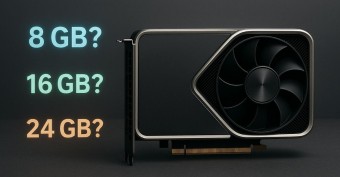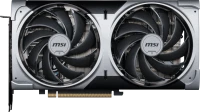Скільки пам'яті потрібно відеокарті у 2025 році
Ми незалежно перевіряємо товари та технології, які рекомендуємо.

1. Що таке VRAM і за що вона відповідає

Відеопам'ять (VRAM) — це спеціалізована високошвидкісна пам'ять відеокарти, яка служить буфером для зберігання всіх даних, необхідних для відтворення зображення на екрані. У неї завантажуються текстури, шейдери, полігони, структури для трасування променів (наприклад, BVH) і навіть дані для алгоритмів ШІ, таких як NVIDIA DLSS. Чим більше VRAM і чим вона швидше, тим краще відеокарта справляється із сучасними іграми, особливо у високих роздільних здатностях і з трасуванням променів.
Низька продуктивність та «слайдшоу»
Коли відеокарта не має достатньо відеопам’яті для зберігання всіх необхідних текстур і даних, це може призвести до різкого зниження продуктивності. Гра стає непридатною для гри, і ви бачите вкрай низький FPS, що робить ігровий процес практично неможливим. Це найочевидніший варіант.

Статери та розрив фреймтайму
У разі нестачі відеопам'яті, може збільшитися час на відтворення одного кадру (frame time), внаслідок чого лічильник FPS буде показувати умовні 60 FPS, але через постійні стрибки фреймтайму за відчуттями це буде близько до 30 FPS. З останніх прикладів можна пригадати Залісся у S.T.A.L.K.E.R. 2.
Знижена якість текстур
Коли відеопам'яті мало, гра може динамічно знижувати якість текстур для оптимізації. Наприклад, вони можуть почати завантажуватися прямо перед вашими очима (привіт, люди-картоплі у Cyberpunk 2077). Або завантажитися в низькій роздільній здатності. Або почати мерехтіти.
Особливо сильно нестача VRAM проявляється в останні пару років, коли всі розробники почали переходити на Unreal Engine 5 зі своїми надзвичайно вимогливими до об'єму пам'яті нанітами і глобальним освітленням Lumen.
2. Навіщо потрібно багато VRAM?

Зростання вимог до об'єму відеопам'яті безпосередньо пов'язано з кількома факторами. По-перше, все більше користувачів переходять на ігри в роздільних здатностях 2K і 4K, де навантаження на VRAM зростає пропорційно кількості пікселів. По-друге, індустрія загалом змістилася у бік фотореалістичного візуалу, через що зросли розміри текстур і складність моделей.
Якщо раніше для відображення каменя у кадрі було достатньо однієї текстури, яка багаторазово повторювалася, то зараз розробники застосовують 4K- і навіть 8K-текстури з масками, нормалями і PBR-матеріалами, щоб досягти унікального та реалістичного вигляду кожного об’єкта. Подібний підхід дозволяє створювати живописні та насичені сцени, але потребує величезних обсягів відеопам’яті.

нагадуючи графіку Minecraft або олдскульних ігор кінця 90-х.
З появою Unreal Engine 5 та його системи Nanite, складність геометрії також зросла на порядок. Замість десятків тисяч полігонів рушій легко обробляє сотні тисяч або мільйони — на один об'єкт. Nanite дозволяє не замислюватися про оптимізацію геометрії, проте всі ці дані повинні десь зберігатися — і цим «десь» стає VRAM. Додаткове навантаження створює технологія Lumen — динамічне глобальне освітлення, яке моделює поведінку світла в сцені в реальному часі. Вона особливо сильно навантажує GPU і пам'ять при високих налаштуваннях якості та великих ігрових просторах.
Зросли вимоги і до створення персонажів. Наприклад, у старих іграх на кшталт GTA 3 Vice City на фігурку Тоні фактично натягували одну єдину текстуру з штанами, гавайською сорочкою та кедами. Порівняйте це з нещодавньою Dragon Age: The Veilguard для якої команда Bioware розробила окрему технологію симуляції волосся під назвою Strand Hair, у якій освітлення та полігони розраховуються у реальному часі за допомогою вузького конуса світла, що точно повторює форму кожного волоска.
3. Тести у іграх: 8 ГБ проти 16 ГБ в 1080p та 1440p

Через затримки постачання нової GeForce RTX 5060 Ti з 8 ГБ пам'яті, всі тести проводились на попередниці RTX 4060 Ti. Ігри запускалися в роздільних здатностях 1080p і 1440p з максимальними графічними налаштуваннями, без трасування променів, DLSS і генерації кадрів. Це дозволило мінімізувати вплив допоміжних технологій на результати і зосередитися виключно на впливі об’єму VRAM. Порівнювалися показники середнього FPS і 1% Low — останній особливо важливий для розуміння стабільності та плавності зображення в навантажених сценах.
Судячи з тестів, вплив об’єму відеопам'яті безпосередньо залежить від конкретної гри. У таких проектах, як Cyberpunk 2077 і Hellblade 2, приріст від 16 ГБ мінімальний. Навіть Starfield, за загальною любов’ю Bethesda до ресурсоємних локацій, демонструє відчутну різницю лише в густонаселених районах з великою кількістю NPC.
| GeForce RTX 4060 Ti 8 GB | GeForce RTX 4060 Ti 16 GB | |
|---|---|---|
| Black Myth: Wukong | 51 / 40 FPS (AVG / 1% Low) | 52 / 42 FPS (AVG / 1% Low) |
| Cyberpunk 2077 | 88 / 59 FPS (AVG / 1% Low) | 91 / 64 FPS (AVG / 1% Low) |
| Resident Evil 4 | 71 / 15 FPS (AVG / 1% Low) | 75 / 63 FPS (AVG / 1% Low) |
| S.T.A.L.K.E.R. 2: Heart of Chornobyl | 58 / 25 FPS (AVG / 1% Low) | 65 / 46 FPS (AVG / 1% Low) |
| Alan Wake 2 | 57 / 42 FPS (AVG / 1% Low) | 61 / 48 FPS (AVG / 1% Low) |
| Horizon Forbidden West | 76 / 47 FPS (AVG / 1% Low) | 83 / 69 FPS (AVG / 1% Low) |
| Ghost of Tsushima | 84 / 73 FPS (AVG / 1% Low) | 84 / 73 FPS (AVG / 1% Low) |
| Hellblade 2 | 55 / 45 FPS (AVG / 1% Low) | 55 / 47 FPS (AVG / 1% Low) |
| Starfield | 53 / 34 FPS (AVG / 1% Low) | 53 / 35 FPS (AVG / 1% Low) |
Цікава картина спостерігається у портах з PS4. У Horizon Forbidden West відеокарта з 16 ГБ демонструє приріст майже на 10% за середнім FPS, а показник 1% Low зростає приблизно в півтора рази — як у 1080p, так і у 1440p. А ось Ghost of Tsushima, навпаки, практично не реагує на збільшення об’єму відеопам’яті, показуючи ідентичні результати незалежно від конфігурації.
| GeForce RTX 4060 Ti 8 GB | GeForce RTX 4060 Ti 16 GB | |
|---|---|---|
| Black Myth: Wukong | 42 / 36 FPS (AVG / 1% Low) | 43 / 36 FPS (AVG / 1% Low) |
| Cyberpunk 2077 | 52 / 38 FPS (AVG / 1% Low) | 55 / 42 FPS (AVG / 1% Low) |
| Avatar: Frontiers of Pandora | 39 / 32 FPS (AVG / 1% Low) | 40 / 34 FPS (AVG / 1% Low) |
| S.T.A.L.K.E.R. 2: Heart of Chornobyl | 39 / 19 FPS (AVG / 1% Low) | 44 / 35 FPS (AVG / 1% Low) |
| Alan Wake 2 | 37 / 28 FPS (AVG / 1% Low) | 41 / 31 FPS (AVG / 1% Low) |
| Horizon Forbidden West | 53 / 36 FPS (AVG / 1% Low) | 60 / 51 FPS (AVG / 1% Low) |
| Ghost of Tsushima | 59 / 51 FPS (AVG / 1% Low) | 59 / 52 FPS (AVG / 1% Low) |
| Hellblade 2 | 38 / 30 FPS (AVG / 1% Low) | 39 / 33 FPS (AVG / 1% Low) |
| Starfield | 41 / 27 FPS (AVG / 1% Low) | 41 / 31 FPS (AVG / 1% Low) |
Втім, з'являється все більше зворотних прикладів. У S.T.A.L.K.E.R. 2: Heart of Chornobyl, при встановленні графічного профілю на «Епічний», версія з 8 ГБ починає помітно провисати — з 58 до 25 FPS. А в 1440p з максимальними налаштуваннями ігровий процес перетворюється на слайд-шоу. Хоча і на 16 ГБ все далеко від ідеалу — оптимізація поки що залишає бажати кращого, але принаймні можна грати.
Особливо сильно виділяється з загальної картини Resident Evil 4 — при використанні «Максимального» пресету 8 ГБ відеопам'яті заповнюються майже миттєво, фреймрейт починає скакати між нормальними 70 і абсолютно не придатними для гри 15 FPS. При активації трасування променів гра на 8 ГБ і зовсім відмовляється запускатися.
Hogwarts Legacy демонструє схожу поведінку — в 1440p на ультра-настройках 8 ГБ заповнюються дуже швидко, після чого гра починає вилітати. На відеокарті з 16 ГБ все значно стабільніше: гра спокійно працює на «Ультра», з можливістю активувати трасування променів. Таку поведінку складно відобразити цифрами в таблиці, тому Hogwarts Legacy ми винесли за дужки.
4. Отже, скільки VRAM оптимально у 2025 році?

З одного боку багатьом сучасним іграм цілком вистачає і 8 ГБ VRAM. Особливо якщо ви надаєте перевагу гри в 1080p і не проти пограти з налаштуваннями графіки. Проте тести наочно демонструють: вже зараз є чимало ігор, у яких максимальні графічні налаштування вимагають 10 – 12, а іноді й понад 14 ГБ відеопам'яті. У цих випадках адаптер з 8 ГБ починає відчувати нестачу ресурсів — з'являються просадки FPS, мікрофризи, підергування. Іноді це доходить до графічних артефактів, зависань і вилітів із гри.
Якщо узагальнити, на 2025 рік складається така картина:
- 4 ГБ — нижче мінімального порогу. Підходить для мережевих ігор, хітів минулих років (The Witcher 3) і за певної удачі дозволить пограти у добре оптимізовані проекти поточного покоління.
- 6 ГБ ― краще, ніж 4 ГБ, але все одно мало за мірками 2025 року. Втім у сучасних відеокартах такий обсяг практично не зустрічається.
- 8 ГБ — базовий мінімум для запуску сучасних ААА-ігор у 1080p. Хоча, в деяких випадках не вистачає вже й цього.
- 10 ГБ — проміжний варіант, поки що вистачає, але перспектива на майбутнє обмежена.
- 12 ГБ — комфортний обсяг для ігор у 1440p.
- 16 ГБ — оптимально для 1440p з трасуванням променів і запасом для 4K.
- 24 ГБ — вибір для професійних завдань та ентузіастів, котрі грають у 4K з трасуванням променів та максимальними налаштуваннями.
- 32 ГБ ― варіант у стилі «безтурботна старість» для найбільш забезпечених користувачів. Це величезний запас VRAM на роки вперед, втім на даний момент (квітень 2025 року) похвалитися подібним може лише флагман GeForce RTX 5090.
При цьому важливо враховувати кілька нюансів. По-перше, сама модель відеокарти в більшості випадків грає набагато важливішу роль, ніж обсяг VRAM. Наприклад, RTX 4070 з 12 ГБ буде помітно продуктивнішою, ніж RTX 4060 Ti з 16 ГБ. По-друге, наведені орієнтири актуальні насамперед для ААА-проектів 2024 – 2025 років, багато з яких розроблені на Unreal Engine 5 та інших сучасних рушіях, які потребують значно більшого обсягу ресурсів порівняно з іграми п'ятирічної давнини.
Статті, огляди, корисні поради
Усі матеріали







































































